Brand Building and Product Diversification Strategy of Coca-Cola
VerifiedAdded on 2022/12/09
|16
|5360
|230
AI Summary
This report analyzes the brand building efforts and product diversification strategy of Coca-Cola in the carbonated beverage segment. It discusses their marketing techniques, product range, and rationale behind their multi-branding strategy.
Contribute Materials
Your contribution can guide someone’s learning journey. Share your
documents today.
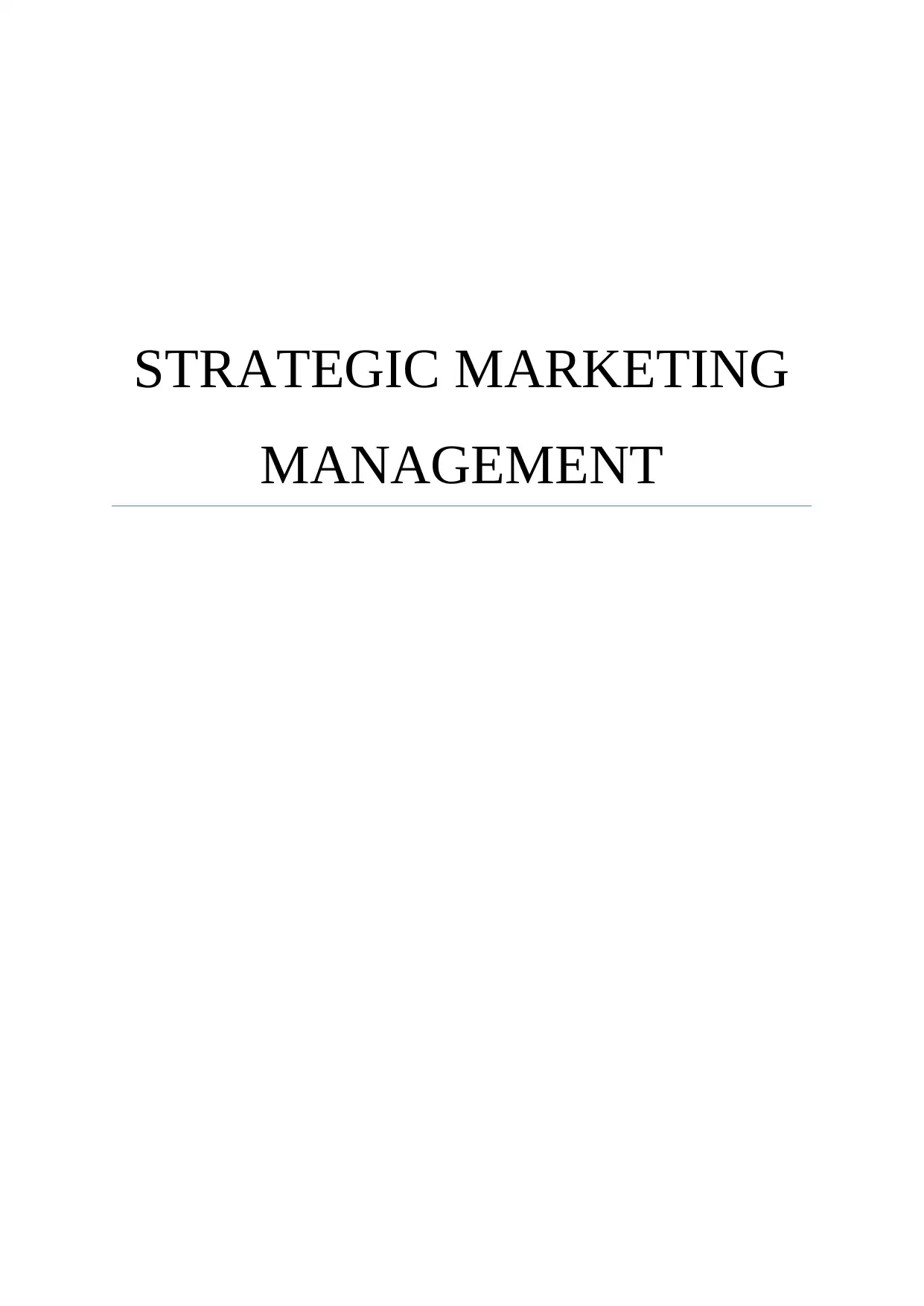
STRATEGIC MARKETING
MANAGEMENT
MANAGEMENT
Secure Best Marks with AI Grader
Need help grading? Try our AI Grader for instant feedback on your assignments.
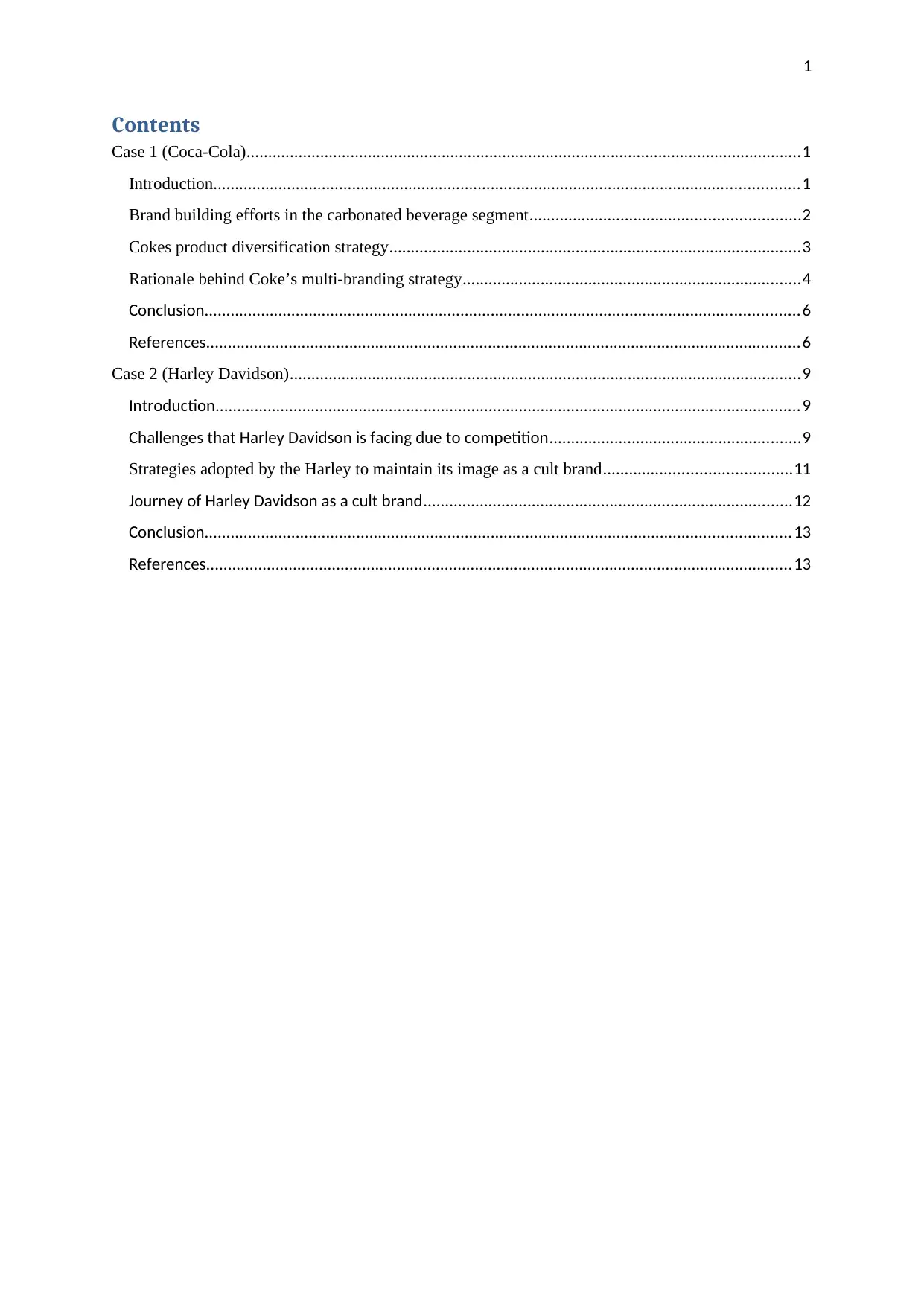
1
Contents
Case 1 (Coca-Cola)................................................................................................................................1
Introduction.......................................................................................................................................1
Brand building efforts in the carbonated beverage segment..............................................................2
Cokes product diversification strategy...............................................................................................3
Rationale behind Coke’s multi-branding strategy..............................................................................4
Conclusion.........................................................................................................................................6
References.........................................................................................................................................6
Case 2 (Harley Davidson)......................................................................................................................9
Introduction.......................................................................................................................................9
Challenges that Harley Davidson is facing due to competition..........................................................9
Strategies adopted by the Harley to maintain its image as a cult brand...........................................11
Journey of Harley Davidson as a cult brand.....................................................................................12
Conclusion.......................................................................................................................................13
References.......................................................................................................................................13
Contents
Case 1 (Coca-Cola)................................................................................................................................1
Introduction.......................................................................................................................................1
Brand building efforts in the carbonated beverage segment..............................................................2
Cokes product diversification strategy...............................................................................................3
Rationale behind Coke’s multi-branding strategy..............................................................................4
Conclusion.........................................................................................................................................6
References.........................................................................................................................................6
Case 2 (Harley Davidson)......................................................................................................................9
Introduction.......................................................................................................................................9
Challenges that Harley Davidson is facing due to competition..........................................................9
Strategies adopted by the Harley to maintain its image as a cult brand...........................................11
Journey of Harley Davidson as a cult brand.....................................................................................12
Conclusion.......................................................................................................................................13
References.......................................................................................................................................13
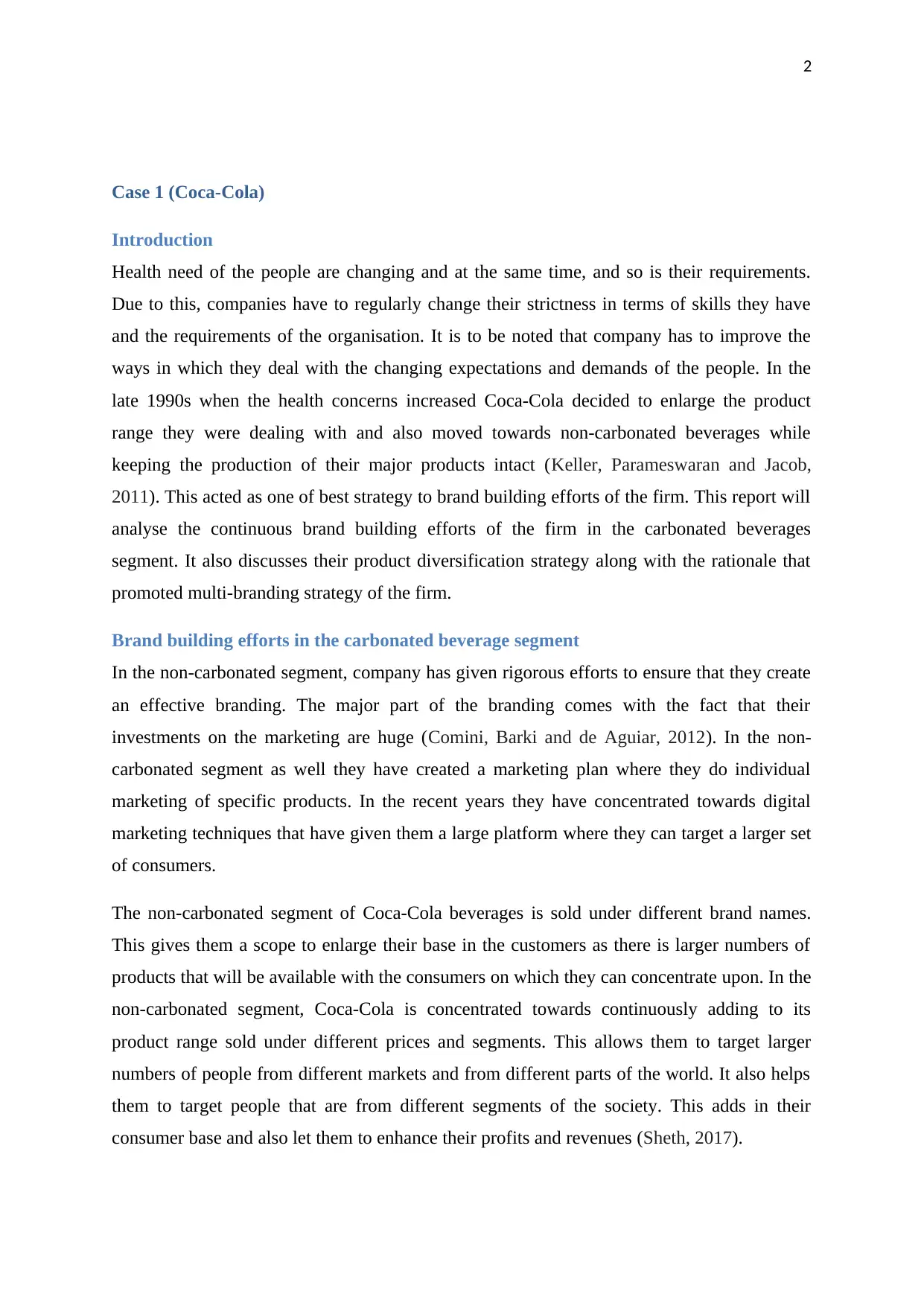
2
Case 1 (Coca-Cola)
Introduction
Health need of the people are changing and at the same time, and so is their requirements.
Due to this, companies have to regularly change their strictness in terms of skills they have
and the requirements of the organisation. It is to be noted that company has to improve the
ways in which they deal with the changing expectations and demands of the people. In the
late 1990s when the health concerns increased Coca-Cola decided to enlarge the product
range they were dealing with and also moved towards non-carbonated beverages while
keeping the production of their major products intact (Keller, Parameswaran and Jacob,
2011). This acted as one of best strategy to brand building efforts of the firm. This report will
analyse the continuous brand building efforts of the firm in the carbonated beverages
segment. It also discusses their product diversification strategy along with the rationale that
promoted multi-branding strategy of the firm.
Brand building efforts in the carbonated beverage segment
In the non-carbonated segment, company has given rigorous efforts to ensure that they create
an effective branding. The major part of the branding comes with the fact that their
investments on the marketing are huge (Comini, Barki and de Aguiar, 2012). In the non-
carbonated segment as well they have created a marketing plan where they do individual
marketing of specific products. In the recent years they have concentrated towards digital
marketing techniques that have given them a large platform where they can target a larger set
of consumers.
The non-carbonated segment of Coca-Cola beverages is sold under different brand names.
This gives them a scope to enlarge their base in the customers as there is larger numbers of
products that will be available with the consumers on which they can concentrate upon. In the
non-carbonated segment, Coca-Cola is concentrated towards continuously adding to its
product range sold under different prices and segments. This allows them to target larger
numbers of people from different markets and from different parts of the world. It also helps
them to target people that are from different segments of the society. This adds in their
consumer base and also let them to enhance their profits and revenues (Sheth, 2017).
Case 1 (Coca-Cola)
Introduction
Health need of the people are changing and at the same time, and so is their requirements.
Due to this, companies have to regularly change their strictness in terms of skills they have
and the requirements of the organisation. It is to be noted that company has to improve the
ways in which they deal with the changing expectations and demands of the people. In the
late 1990s when the health concerns increased Coca-Cola decided to enlarge the product
range they were dealing with and also moved towards non-carbonated beverages while
keeping the production of their major products intact (Keller, Parameswaran and Jacob,
2011). This acted as one of best strategy to brand building efforts of the firm. This report will
analyse the continuous brand building efforts of the firm in the carbonated beverages
segment. It also discusses their product diversification strategy along with the rationale that
promoted multi-branding strategy of the firm.
Brand building efforts in the carbonated beverage segment
In the non-carbonated segment, company has given rigorous efforts to ensure that they create
an effective branding. The major part of the branding comes with the fact that their
investments on the marketing are huge (Comini, Barki and de Aguiar, 2012). In the non-
carbonated segment as well they have created a marketing plan where they do individual
marketing of specific products. In the recent years they have concentrated towards digital
marketing techniques that have given them a large platform where they can target a larger set
of consumers.
The non-carbonated segment of Coca-Cola beverages is sold under different brand names.
This gives them a scope to enlarge their base in the customers as there is larger numbers of
products that will be available with the consumers on which they can concentrate upon. In the
non-carbonated segment, Coca-Cola is concentrated towards continuously adding to its
product range sold under different prices and segments. This allows them to target larger
numbers of people from different markets and from different parts of the world. It also helps
them to target people that are from different segments of the society. This adds in their
consumer base and also let them to enhance their profits and revenues (Sheth, 2017).
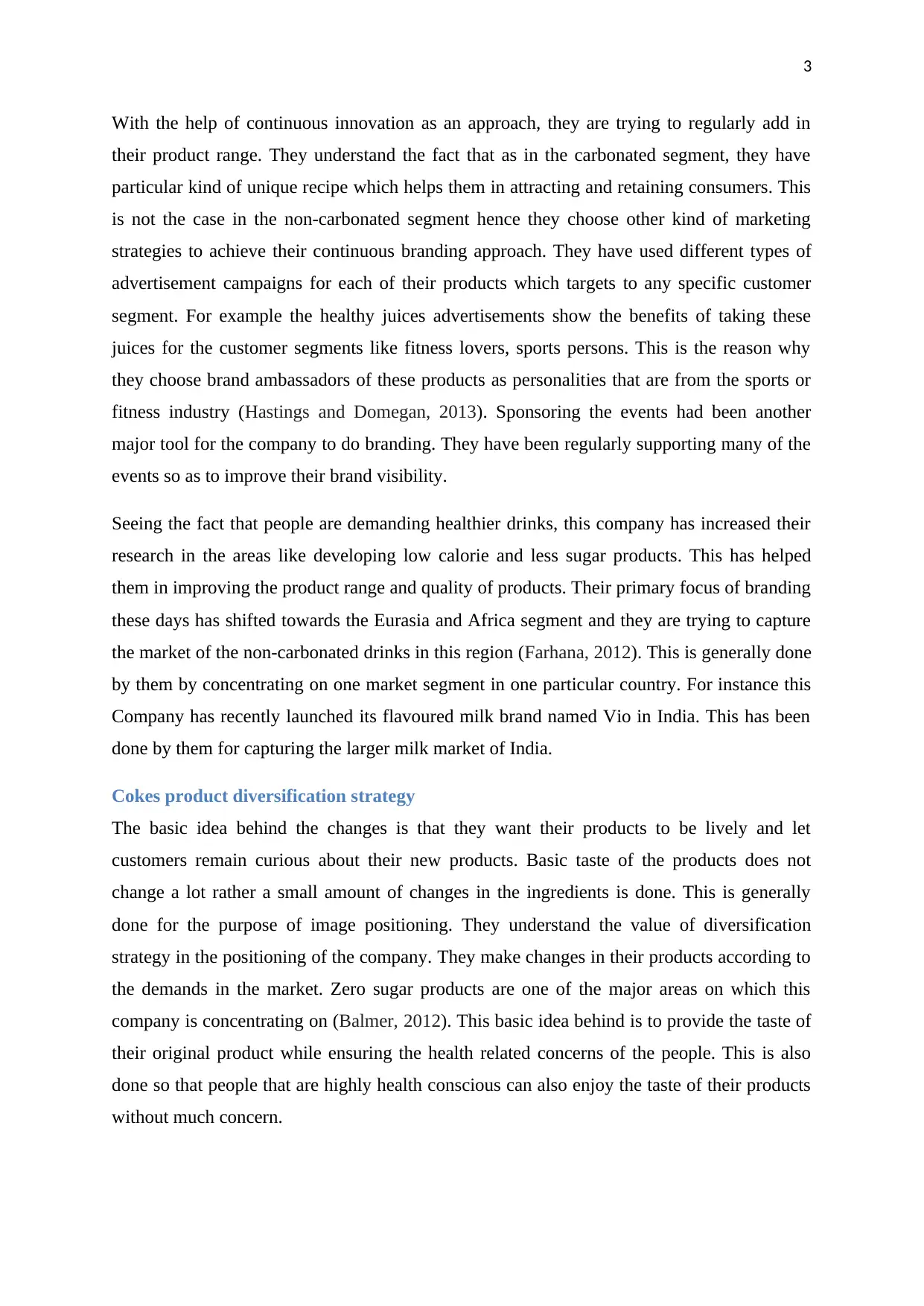
3
With the help of continuous innovation as an approach, they are trying to regularly add in
their product range. They understand the fact that as in the carbonated segment, they have
particular kind of unique recipe which helps them in attracting and retaining consumers. This
is not the case in the non-carbonated segment hence they choose other kind of marketing
strategies to achieve their continuous branding approach. They have used different types of
advertisement campaigns for each of their products which targets to any specific customer
segment. For example the healthy juices advertisements show the benefits of taking these
juices for the customer segments like fitness lovers, sports persons. This is the reason why
they choose brand ambassadors of these products as personalities that are from the sports or
fitness industry (Hastings and Domegan, 2013). Sponsoring the events had been another
major tool for the company to do branding. They have been regularly supporting many of the
events so as to improve their brand visibility.
Seeing the fact that people are demanding healthier drinks, this company has increased their
research in the areas like developing low calorie and less sugar products. This has helped
them in improving the product range and quality of products. Their primary focus of branding
these days has shifted towards the Eurasia and Africa segment and they are trying to capture
the market of the non-carbonated drinks in this region (Farhana, 2012). This is generally done
by them by concentrating on one market segment in one particular country. For instance this
Company has recently launched its flavoured milk brand named Vio in India. This has been
done by them for capturing the larger milk market of India.
Cokes product diversification strategy
The basic idea behind the changes is that they want their products to be lively and let
customers remain curious about their new products. Basic taste of the products does not
change a lot rather a small amount of changes in the ingredients is done. This is generally
done for the purpose of image positioning. They understand the value of diversification
strategy in the positioning of the company. They make changes in their products according to
the demands in the market. Zero sugar products are one of the major areas on which this
company is concentrating on (Balmer, 2012). This basic idea behind is to provide the taste of
their original product while ensuring the health related concerns of the people. This is also
done so that people that are highly health conscious can also enjoy the taste of their products
without much concern.
With the help of continuous innovation as an approach, they are trying to regularly add in
their product range. They understand the fact that as in the carbonated segment, they have
particular kind of unique recipe which helps them in attracting and retaining consumers. This
is not the case in the non-carbonated segment hence they choose other kind of marketing
strategies to achieve their continuous branding approach. They have used different types of
advertisement campaigns for each of their products which targets to any specific customer
segment. For example the healthy juices advertisements show the benefits of taking these
juices for the customer segments like fitness lovers, sports persons. This is the reason why
they choose brand ambassadors of these products as personalities that are from the sports or
fitness industry (Hastings and Domegan, 2013). Sponsoring the events had been another
major tool for the company to do branding. They have been regularly supporting many of the
events so as to improve their brand visibility.
Seeing the fact that people are demanding healthier drinks, this company has increased their
research in the areas like developing low calorie and less sugar products. This has helped
them in improving the product range and quality of products. Their primary focus of branding
these days has shifted towards the Eurasia and Africa segment and they are trying to capture
the market of the non-carbonated drinks in this region (Farhana, 2012). This is generally done
by them by concentrating on one market segment in one particular country. For instance this
Company has recently launched its flavoured milk brand named Vio in India. This has been
done by them for capturing the larger milk market of India.
Cokes product diversification strategy
The basic idea behind the changes is that they want their products to be lively and let
customers remain curious about their new products. Basic taste of the products does not
change a lot rather a small amount of changes in the ingredients is done. This is generally
done for the purpose of image positioning. They understand the value of diversification
strategy in the positioning of the company. They make changes in their products according to
the demands in the market. Zero sugar products are one of the major areas on which this
company is concentrating on (Balmer, 2012). This basic idea behind is to provide the taste of
their original product while ensuring the health related concerns of the people. This is also
done so that people that are highly health conscious can also enjoy the taste of their products
without much concern.
Secure Best Marks with AI Grader
Need help grading? Try our AI Grader for instant feedback on your assignments.
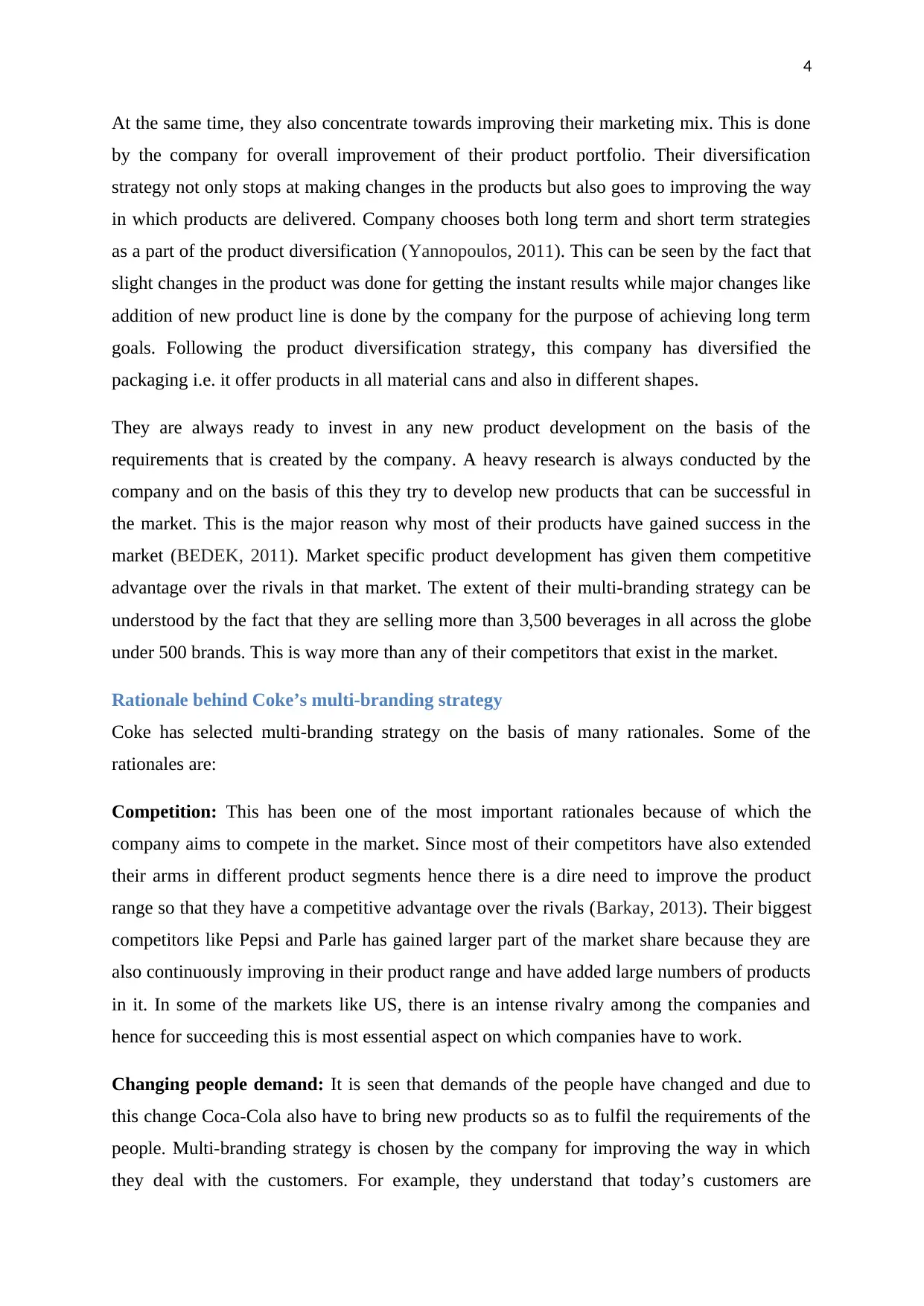
4
At the same time, they also concentrate towards improving their marketing mix. This is done
by the company for overall improvement of their product portfolio. Their diversification
strategy not only stops at making changes in the products but also goes to improving the way
in which products are delivered. Company chooses both long term and short term strategies
as a part of the product diversification (Yannopoulos, 2011). This can be seen by the fact that
slight changes in the product was done for getting the instant results while major changes like
addition of new product line is done by the company for the purpose of achieving long term
goals. Following the product diversification strategy, this company has diversified the
packaging i.e. it offer products in all material cans and also in different shapes.
They are always ready to invest in any new product development on the basis of the
requirements that is created by the company. A heavy research is always conducted by the
company and on the basis of this they try to develop new products that can be successful in
the market. This is the major reason why most of their products have gained success in the
market (BEDEK, 2011). Market specific product development has given them competitive
advantage over the rivals in that market. The extent of their multi-branding strategy can be
understood by the fact that they are selling more than 3,500 beverages in all across the globe
under 500 brands. This is way more than any of their competitors that exist in the market.
Rationale behind Coke’s multi-branding strategy
Coke has selected multi-branding strategy on the basis of many rationales. Some of the
rationales are:
Competition: This has been one of the most important rationales because of which the
company aims to compete in the market. Since most of their competitors have also extended
their arms in different product segments hence there is a dire need to improve the product
range so that they have a competitive advantage over the rivals (Barkay, 2013). Their biggest
competitors like Pepsi and Parle has gained larger part of the market share because they are
also continuously improving in their product range and have added large numbers of products
in it. In some of the markets like US, there is an intense rivalry among the companies and
hence for succeeding this is most essential aspect on which companies have to work.
Changing people demand: It is seen that demands of the people have changed and due to
this change Coca-Cola also have to bring new products so as to fulfil the requirements of the
people. Multi-branding strategy is chosen by the company for improving the way in which
they deal with the customers. For example, they understand that today’s customers are
At the same time, they also concentrate towards improving their marketing mix. This is done
by the company for overall improvement of their product portfolio. Their diversification
strategy not only stops at making changes in the products but also goes to improving the way
in which products are delivered. Company chooses both long term and short term strategies
as a part of the product diversification (Yannopoulos, 2011). This can be seen by the fact that
slight changes in the product was done for getting the instant results while major changes like
addition of new product line is done by the company for the purpose of achieving long term
goals. Following the product diversification strategy, this company has diversified the
packaging i.e. it offer products in all material cans and also in different shapes.
They are always ready to invest in any new product development on the basis of the
requirements that is created by the company. A heavy research is always conducted by the
company and on the basis of this they try to develop new products that can be successful in
the market. This is the major reason why most of their products have gained success in the
market (BEDEK, 2011). Market specific product development has given them competitive
advantage over the rivals in that market. The extent of their multi-branding strategy can be
understood by the fact that they are selling more than 3,500 beverages in all across the globe
under 500 brands. This is way more than any of their competitors that exist in the market.
Rationale behind Coke’s multi-branding strategy
Coke has selected multi-branding strategy on the basis of many rationales. Some of the
rationales are:
Competition: This has been one of the most important rationales because of which the
company aims to compete in the market. Since most of their competitors have also extended
their arms in different product segments hence there is a dire need to improve the product
range so that they have a competitive advantage over the rivals (Barkay, 2013). Their biggest
competitors like Pepsi and Parle has gained larger part of the market share because they are
also continuously improving in their product range and have added large numbers of products
in it. In some of the markets like US, there is an intense rivalry among the companies and
hence for succeeding this is most essential aspect on which companies have to work.
Changing people demand: It is seen that demands of the people have changed and due to
this change Coca-Cola also have to bring new products so as to fulfil the requirements of the
people. Multi-branding strategy is chosen by the company for improving the way in which
they deal with the customers. For example, they understand that today’s customers are
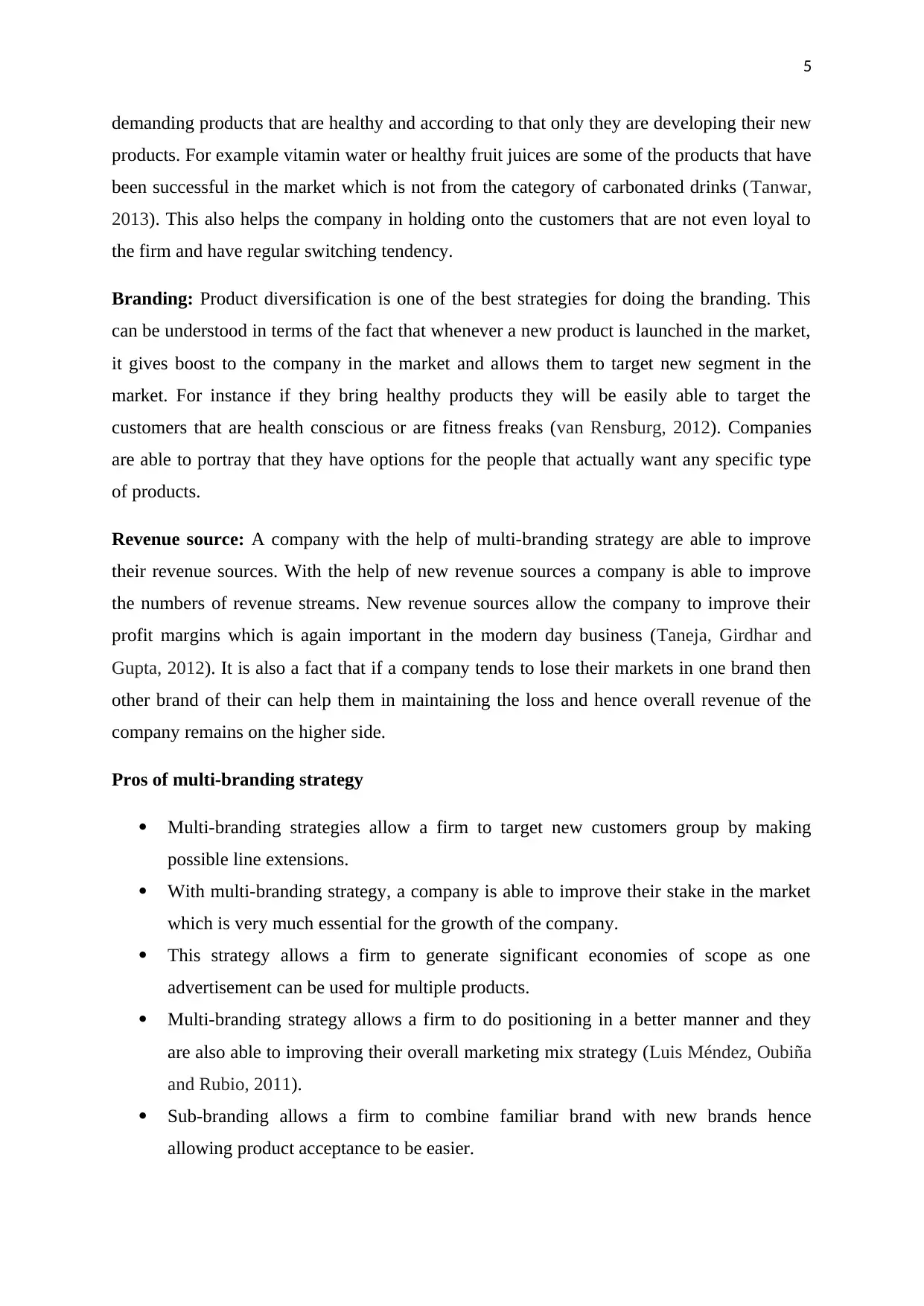
5
demanding products that are healthy and according to that only they are developing their new
products. For example vitamin water or healthy fruit juices are some of the products that have
been successful in the market which is not from the category of carbonated drinks (Tanwar,
2013). This also helps the company in holding onto the customers that are not even loyal to
the firm and have regular switching tendency.
Branding: Product diversification is one of the best strategies for doing the branding. This
can be understood in terms of the fact that whenever a new product is launched in the market,
it gives boost to the company in the market and allows them to target new segment in the
market. For instance if they bring healthy products they will be easily able to target the
customers that are health conscious or are fitness freaks (van Rensburg, 2012). Companies
are able to portray that they have options for the people that actually want any specific type
of products.
Revenue source: A company with the help of multi-branding strategy are able to improve
their revenue sources. With the help of new revenue sources a company is able to improve
the numbers of revenue streams. New revenue sources allow the company to improve their
profit margins which is again important in the modern day business (Taneja, Girdhar and
Gupta, 2012). It is also a fact that if a company tends to lose their markets in one brand then
other brand of their can help them in maintaining the loss and hence overall revenue of the
company remains on the higher side.
Pros of multi-branding strategy
Multi-branding strategies allow a firm to target new customers group by making
possible line extensions.
With multi-branding strategy, a company is able to improve their stake in the market
which is very much essential for the growth of the company.
This strategy allows a firm to generate significant economies of scope as one
advertisement can be used for multiple products.
Multi-branding strategy allows a firm to do positioning in a better manner and they
are also able to improving their overall marketing mix strategy (Luis Méndez, Oubiña
and Rubio, 2011).
Sub-branding allows a firm to combine familiar brand with new brands hence
allowing product acceptance to be easier.
demanding products that are healthy and according to that only they are developing their new
products. For example vitamin water or healthy fruit juices are some of the products that have
been successful in the market which is not from the category of carbonated drinks (Tanwar,
2013). This also helps the company in holding onto the customers that are not even loyal to
the firm and have regular switching tendency.
Branding: Product diversification is one of the best strategies for doing the branding. This
can be understood in terms of the fact that whenever a new product is launched in the market,
it gives boost to the company in the market and allows them to target new segment in the
market. For instance if they bring healthy products they will be easily able to target the
customers that are health conscious or are fitness freaks (van Rensburg, 2012). Companies
are able to portray that they have options for the people that actually want any specific type
of products.
Revenue source: A company with the help of multi-branding strategy are able to improve
their revenue sources. With the help of new revenue sources a company is able to improve
the numbers of revenue streams. New revenue sources allow the company to improve their
profit margins which is again important in the modern day business (Taneja, Girdhar and
Gupta, 2012). It is also a fact that if a company tends to lose their markets in one brand then
other brand of their can help them in maintaining the loss and hence overall revenue of the
company remains on the higher side.
Pros of multi-branding strategy
Multi-branding strategies allow a firm to target new customers group by making
possible line extensions.
With multi-branding strategy, a company is able to improve their stake in the market
which is very much essential for the growth of the company.
This strategy allows a firm to generate significant economies of scope as one
advertisement can be used for multiple products.
Multi-branding strategy allows a firm to do positioning in a better manner and they
are also able to improving their overall marketing mix strategy (Luis Méndez, Oubiña
and Rubio, 2011).
Sub-branding allows a firm to combine familiar brand with new brands hence
allowing product acceptance to be easier.
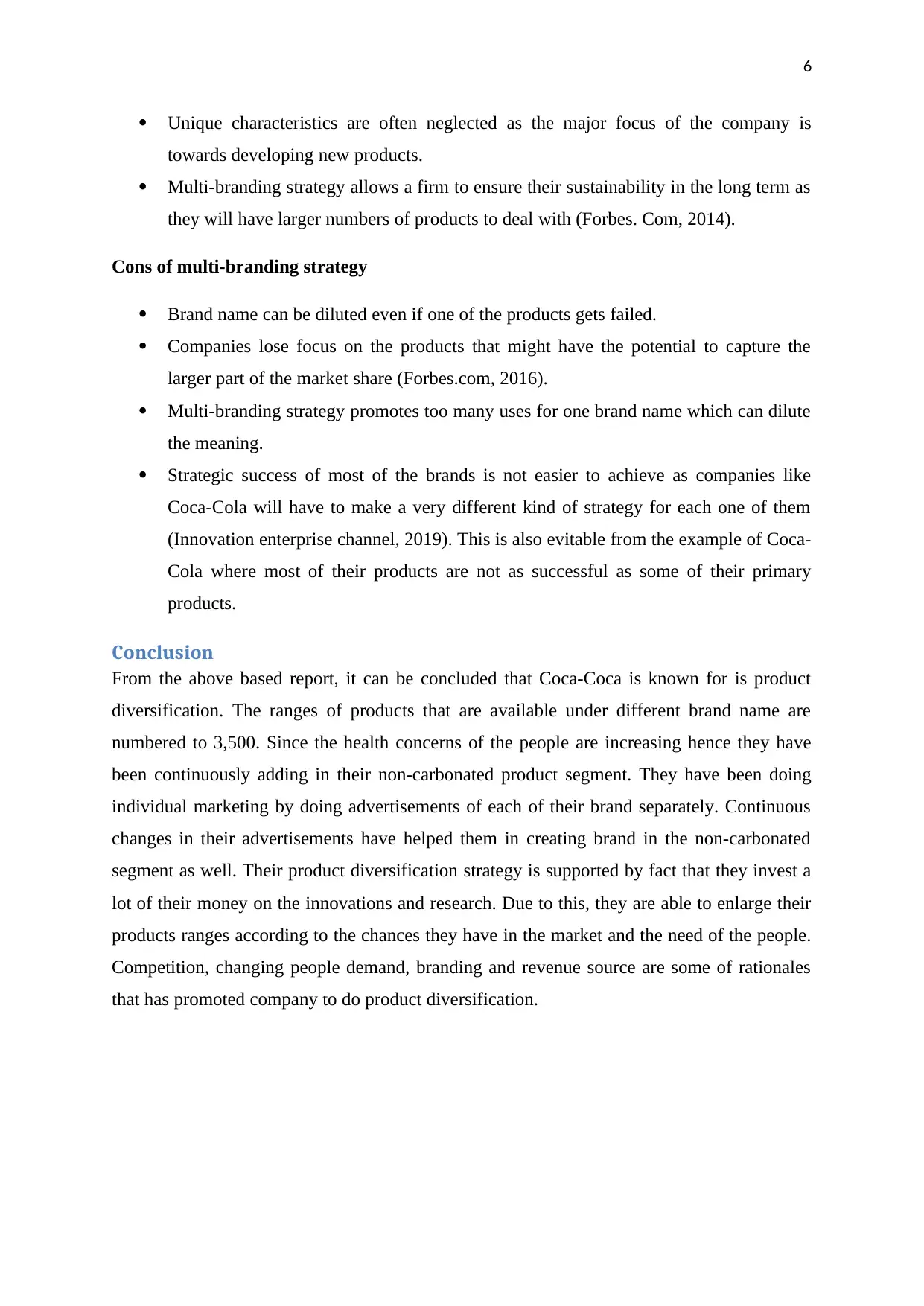
6
Unique characteristics are often neglected as the major focus of the company is
towards developing new products.
Multi-branding strategy allows a firm to ensure their sustainability in the long term as
they will have larger numbers of products to deal with (Forbes. Com, 2014).
Cons of multi-branding strategy
Brand name can be diluted even if one of the products gets failed.
Companies lose focus on the products that might have the potential to capture the
larger part of the market share (Forbes.com, 2016).
Multi-branding strategy promotes too many uses for one brand name which can dilute
the meaning.
Strategic success of most of the brands is not easier to achieve as companies like
Coca-Cola will have to make a very different kind of strategy for each one of them
(Innovation enterprise channel, 2019). This is also evitable from the example of Coca-
Cola where most of their products are not as successful as some of their primary
products.
Conclusion
From the above based report, it can be concluded that Coca-Coca is known for is product
diversification. The ranges of products that are available under different brand name are
numbered to 3,500. Since the health concerns of the people are increasing hence they have
been continuously adding in their non-carbonated product segment. They have been doing
individual marketing by doing advertisements of each of their brand separately. Continuous
changes in their advertisements have helped them in creating brand in the non-carbonated
segment as well. Their product diversification strategy is supported by fact that they invest a
lot of their money on the innovations and research. Due to this, they are able to enlarge their
products ranges according to the chances they have in the market and the need of the people.
Competition, changing people demand, branding and revenue source are some of rationales
that has promoted company to do product diversification.
Unique characteristics are often neglected as the major focus of the company is
towards developing new products.
Multi-branding strategy allows a firm to ensure their sustainability in the long term as
they will have larger numbers of products to deal with (Forbes. Com, 2014).
Cons of multi-branding strategy
Brand name can be diluted even if one of the products gets failed.
Companies lose focus on the products that might have the potential to capture the
larger part of the market share (Forbes.com, 2016).
Multi-branding strategy promotes too many uses for one brand name which can dilute
the meaning.
Strategic success of most of the brands is not easier to achieve as companies like
Coca-Cola will have to make a very different kind of strategy for each one of them
(Innovation enterprise channel, 2019). This is also evitable from the example of Coca-
Cola where most of their products are not as successful as some of their primary
products.
Conclusion
From the above based report, it can be concluded that Coca-Coca is known for is product
diversification. The ranges of products that are available under different brand name are
numbered to 3,500. Since the health concerns of the people are increasing hence they have
been continuously adding in their non-carbonated product segment. They have been doing
individual marketing by doing advertisements of each of their brand separately. Continuous
changes in their advertisements have helped them in creating brand in the non-carbonated
segment as well. Their product diversification strategy is supported by fact that they invest a
lot of their money on the innovations and research. Due to this, they are able to enlarge their
products ranges according to the chances they have in the market and the need of the people.
Competition, changing people demand, branding and revenue source are some of rationales
that has promoted company to do product diversification.
Paraphrase This Document
Need a fresh take? Get an instant paraphrase of this document with our AI Paraphraser
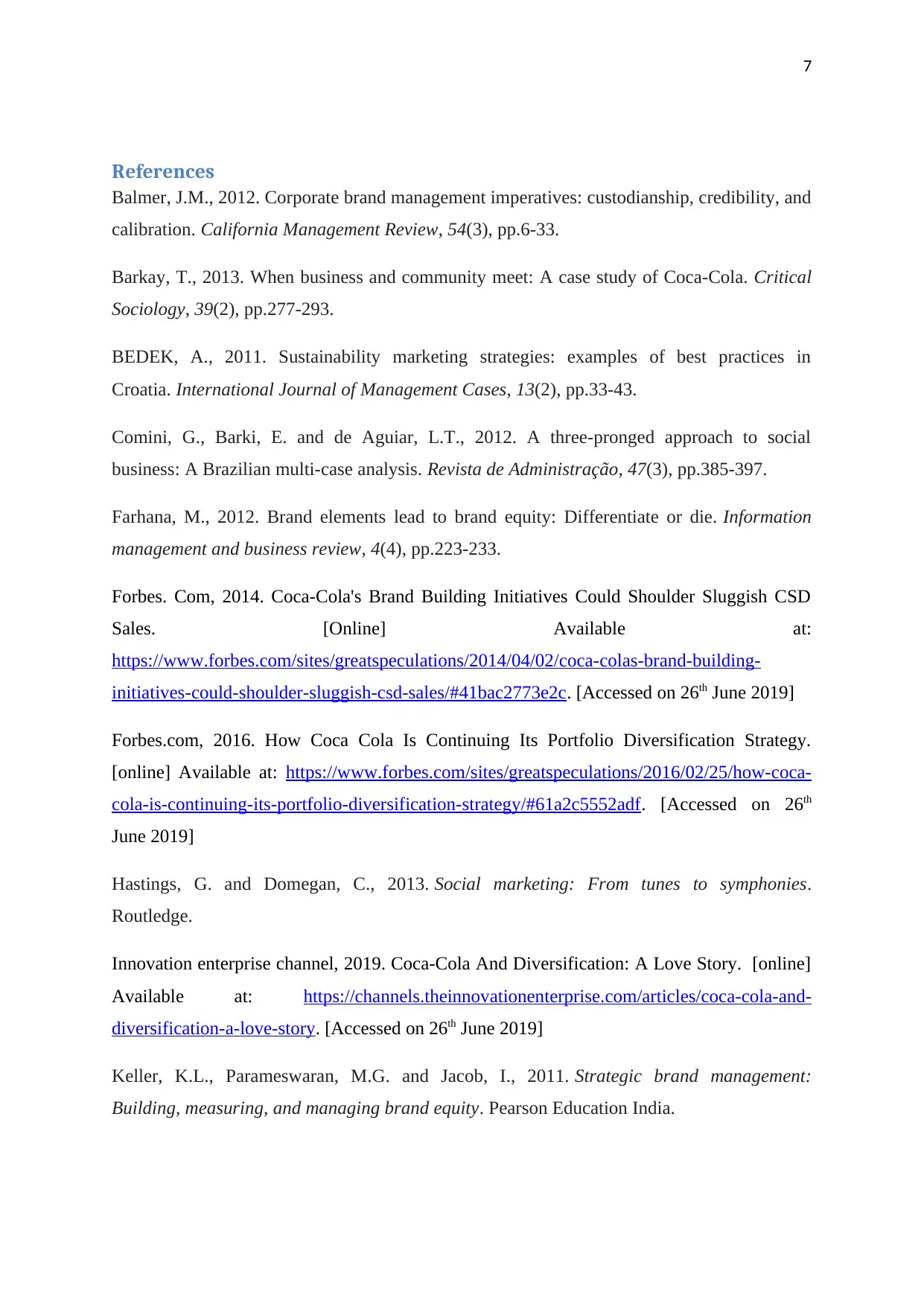
7
References
Balmer, J.M., 2012. Corporate brand management imperatives: custodianship, credibility, and
calibration. California Management Review, 54(3), pp.6-33.
Barkay, T., 2013. When business and community meet: A case study of Coca-Cola. Critical
Sociology, 39(2), pp.277-293.
BEDEK, A., 2011. Sustainability marketing strategies: examples of best practices in
Croatia. International Journal of Management Cases, 13(2), pp.33-43.
Comini, G., Barki, E. and de Aguiar, L.T., 2012. A three-pronged approach to social
business: A Brazilian multi-case analysis. Revista de Administração, 47(3), pp.385-397.
Farhana, M., 2012. Brand elements lead to brand equity: Differentiate or die. Information
management and business review, 4(4), pp.223-233.
Forbes. Com, 2014. Coca-Cola's Brand Building Initiatives Could Shoulder Sluggish CSD
Sales. [Online] Available at:
https://www.forbes.com/sites/greatspeculations/2014/04/02/coca-colas-brand-building-
initiatives-could-shoulder-sluggish-csd-sales/#41bac2773e2c. [Accessed on 26th June 2019]
Forbes.com, 2016. How Coca Cola Is Continuing Its Portfolio Diversification Strategy.
[online] Available at: https://www.forbes.com/sites/greatspeculations/2016/02/25/how-coca-
cola-is-continuing-its-portfolio-diversification-strategy/#61a2c5552adf. [Accessed on 26th
June 2019]
Hastings, G. and Domegan, C., 2013. Social marketing: From tunes to symphonies.
Routledge.
Innovation enterprise channel, 2019. Coca-Cola And Diversification: A Love Story. [online]
Available at: https://channels.theinnovationenterprise.com/articles/coca-cola-and-
diversification-a-love-story. [Accessed on 26th June 2019]
Keller, K.L., Parameswaran, M.G. and Jacob, I., 2011. Strategic brand management:
Building, measuring, and managing brand equity. Pearson Education India.
References
Balmer, J.M., 2012. Corporate brand management imperatives: custodianship, credibility, and
calibration. California Management Review, 54(3), pp.6-33.
Barkay, T., 2013. When business and community meet: A case study of Coca-Cola. Critical
Sociology, 39(2), pp.277-293.
BEDEK, A., 2011. Sustainability marketing strategies: examples of best practices in
Croatia. International Journal of Management Cases, 13(2), pp.33-43.
Comini, G., Barki, E. and de Aguiar, L.T., 2012. A three-pronged approach to social
business: A Brazilian multi-case analysis. Revista de Administração, 47(3), pp.385-397.
Farhana, M., 2012. Brand elements lead to brand equity: Differentiate or die. Information
management and business review, 4(4), pp.223-233.
Forbes. Com, 2014. Coca-Cola's Brand Building Initiatives Could Shoulder Sluggish CSD
Sales. [Online] Available at:
https://www.forbes.com/sites/greatspeculations/2014/04/02/coca-colas-brand-building-
initiatives-could-shoulder-sluggish-csd-sales/#41bac2773e2c. [Accessed on 26th June 2019]
Forbes.com, 2016. How Coca Cola Is Continuing Its Portfolio Diversification Strategy.
[online] Available at: https://www.forbes.com/sites/greatspeculations/2016/02/25/how-coca-
cola-is-continuing-its-portfolio-diversification-strategy/#61a2c5552adf. [Accessed on 26th
June 2019]
Hastings, G. and Domegan, C., 2013. Social marketing: From tunes to symphonies.
Routledge.
Innovation enterprise channel, 2019. Coca-Cola And Diversification: A Love Story. [online]
Available at: https://channels.theinnovationenterprise.com/articles/coca-cola-and-
diversification-a-love-story. [Accessed on 26th June 2019]
Keller, K.L., Parameswaran, M.G. and Jacob, I., 2011. Strategic brand management:
Building, measuring, and managing brand equity. Pearson Education India.
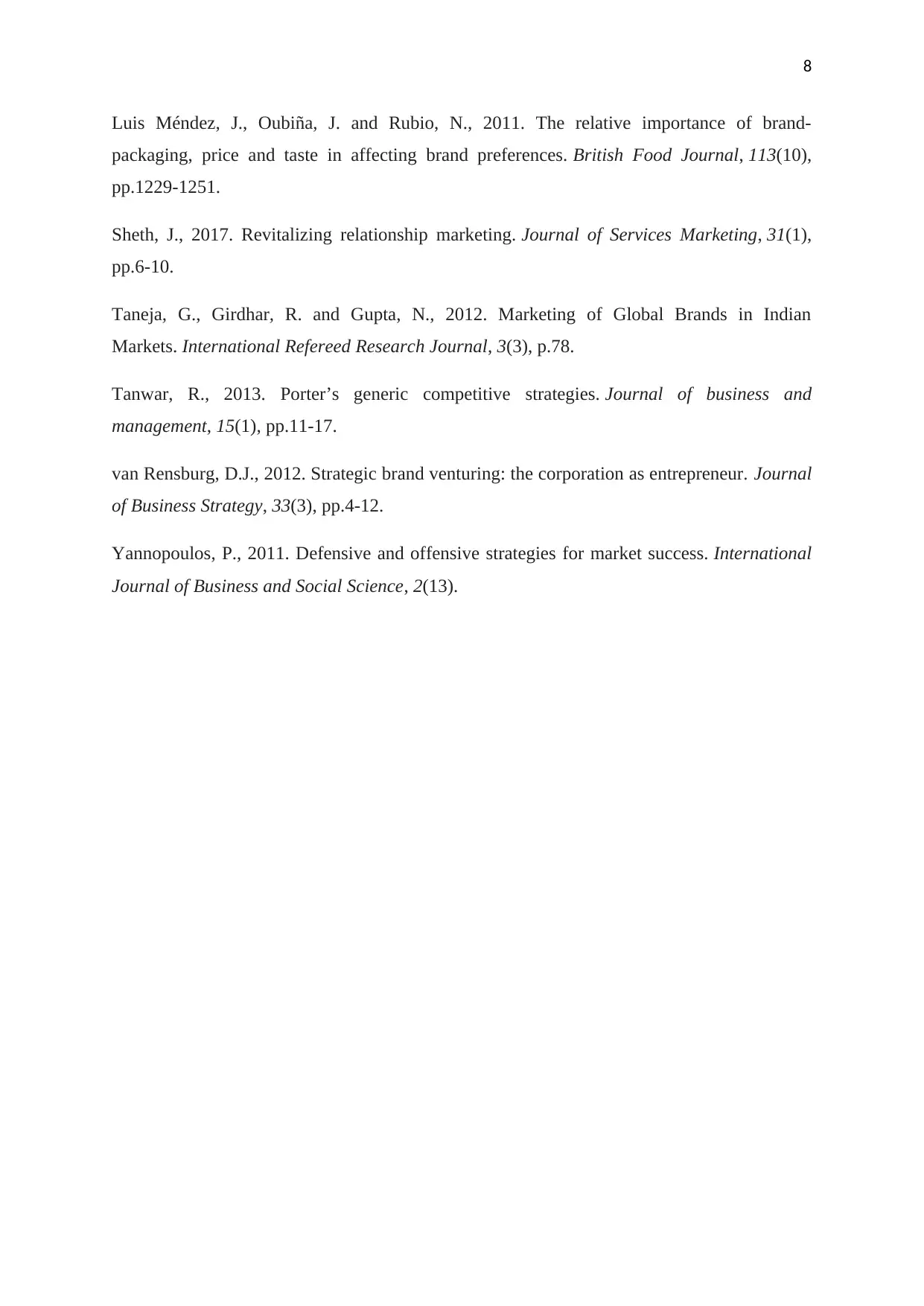
8
Luis Méndez, J., Oubiña, J. and Rubio, N., 2011. The relative importance of brand-
packaging, price and taste in affecting brand preferences. British Food Journal, 113(10),
pp.1229-1251.
Sheth, J., 2017. Revitalizing relationship marketing. Journal of Services Marketing, 31(1),
pp.6-10.
Taneja, G., Girdhar, R. and Gupta, N., 2012. Marketing of Global Brands in Indian
Markets. International Refereed Research Journal, 3(3), p.78.
Tanwar, R., 2013. Porter’s generic competitive strategies. Journal of business and
management, 15(1), pp.11-17.
van Rensburg, D.J., 2012. Strategic brand venturing: the corporation as entrepreneur. Journal
of Business Strategy, 33(3), pp.4-12.
Yannopoulos, P., 2011. Defensive and offensive strategies for market success. International
Journal of Business and Social Science, 2(13).
Luis Méndez, J., Oubiña, J. and Rubio, N., 2011. The relative importance of brand-
packaging, price and taste in affecting brand preferences. British Food Journal, 113(10),
pp.1229-1251.
Sheth, J., 2017. Revitalizing relationship marketing. Journal of Services Marketing, 31(1),
pp.6-10.
Taneja, G., Girdhar, R. and Gupta, N., 2012. Marketing of Global Brands in Indian
Markets. International Refereed Research Journal, 3(3), p.78.
Tanwar, R., 2013. Porter’s generic competitive strategies. Journal of business and
management, 15(1), pp.11-17.
van Rensburg, D.J., 2012. Strategic brand venturing: the corporation as entrepreneur. Journal
of Business Strategy, 33(3), pp.4-12.
Yannopoulos, P., 2011. Defensive and offensive strategies for market success. International
Journal of Business and Social Science, 2(13).
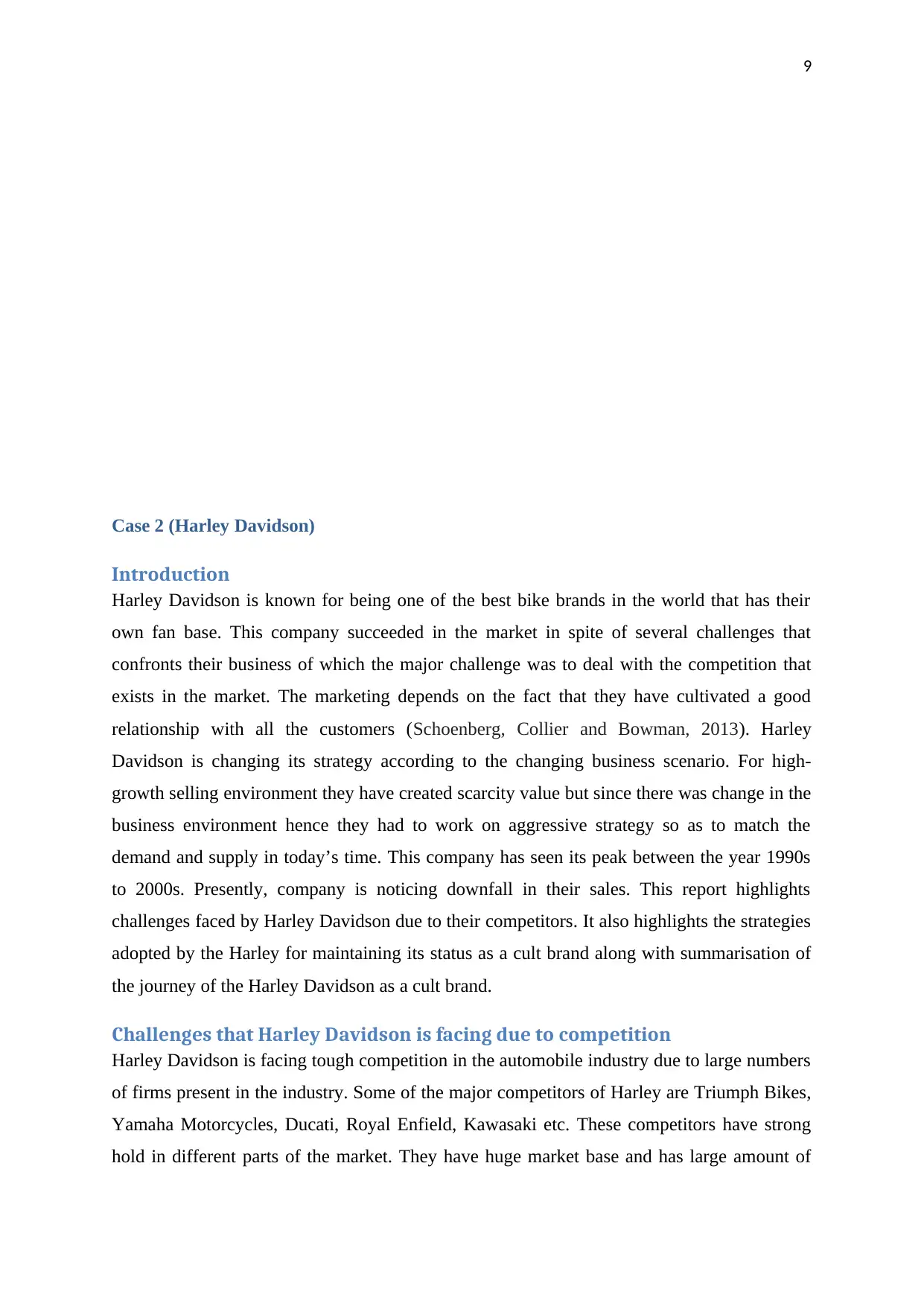
9
Case 2 (Harley Davidson)
Introduction
Harley Davidson is known for being one of the best bike brands in the world that has their
own fan base. This company succeeded in the market in spite of several challenges that
confronts their business of which the major challenge was to deal with the competition that
exists in the market. The marketing depends on the fact that they have cultivated a good
relationship with all the customers (Schoenberg, Collier and Bowman, 2013). Harley
Davidson is changing its strategy according to the changing business scenario. For high-
growth selling environment they have created scarcity value but since there was change in the
business environment hence they had to work on aggressive strategy so as to match the
demand and supply in today’s time. This company has seen its peak between the year 1990s
to 2000s. Presently, company is noticing downfall in their sales. This report highlights
challenges faced by Harley Davidson due to their competitors. It also highlights the strategies
adopted by the Harley for maintaining its status as a cult brand along with summarisation of
the journey of the Harley Davidson as a cult brand.
Challenges that Harley Davidson is facing due to competition
Harley Davidson is facing tough competition in the automobile industry due to large numbers
of firms present in the industry. Some of the major competitors of Harley are Triumph Bikes,
Yamaha Motorcycles, Ducati, Royal Enfield, Kawasaki etc. These competitors have strong
hold in different parts of the market. They have huge market base and has large amount of
Case 2 (Harley Davidson)
Introduction
Harley Davidson is known for being one of the best bike brands in the world that has their
own fan base. This company succeeded in the market in spite of several challenges that
confronts their business of which the major challenge was to deal with the competition that
exists in the market. The marketing depends on the fact that they have cultivated a good
relationship with all the customers (Schoenberg, Collier and Bowman, 2013). Harley
Davidson is changing its strategy according to the changing business scenario. For high-
growth selling environment they have created scarcity value but since there was change in the
business environment hence they had to work on aggressive strategy so as to match the
demand and supply in today’s time. This company has seen its peak between the year 1990s
to 2000s. Presently, company is noticing downfall in their sales. This report highlights
challenges faced by Harley Davidson due to their competitors. It also highlights the strategies
adopted by the Harley for maintaining its status as a cult brand along with summarisation of
the journey of the Harley Davidson as a cult brand.
Challenges that Harley Davidson is facing due to competition
Harley Davidson is facing tough competition in the automobile industry due to large numbers
of firms present in the industry. Some of the major competitors of Harley are Triumph Bikes,
Yamaha Motorcycles, Ducati, Royal Enfield, Kawasaki etc. These competitors have strong
hold in different parts of the market. They have huge market base and has large amount of
Secure Best Marks with AI Grader
Need help grading? Try our AI Grader for instant feedback on your assignments.
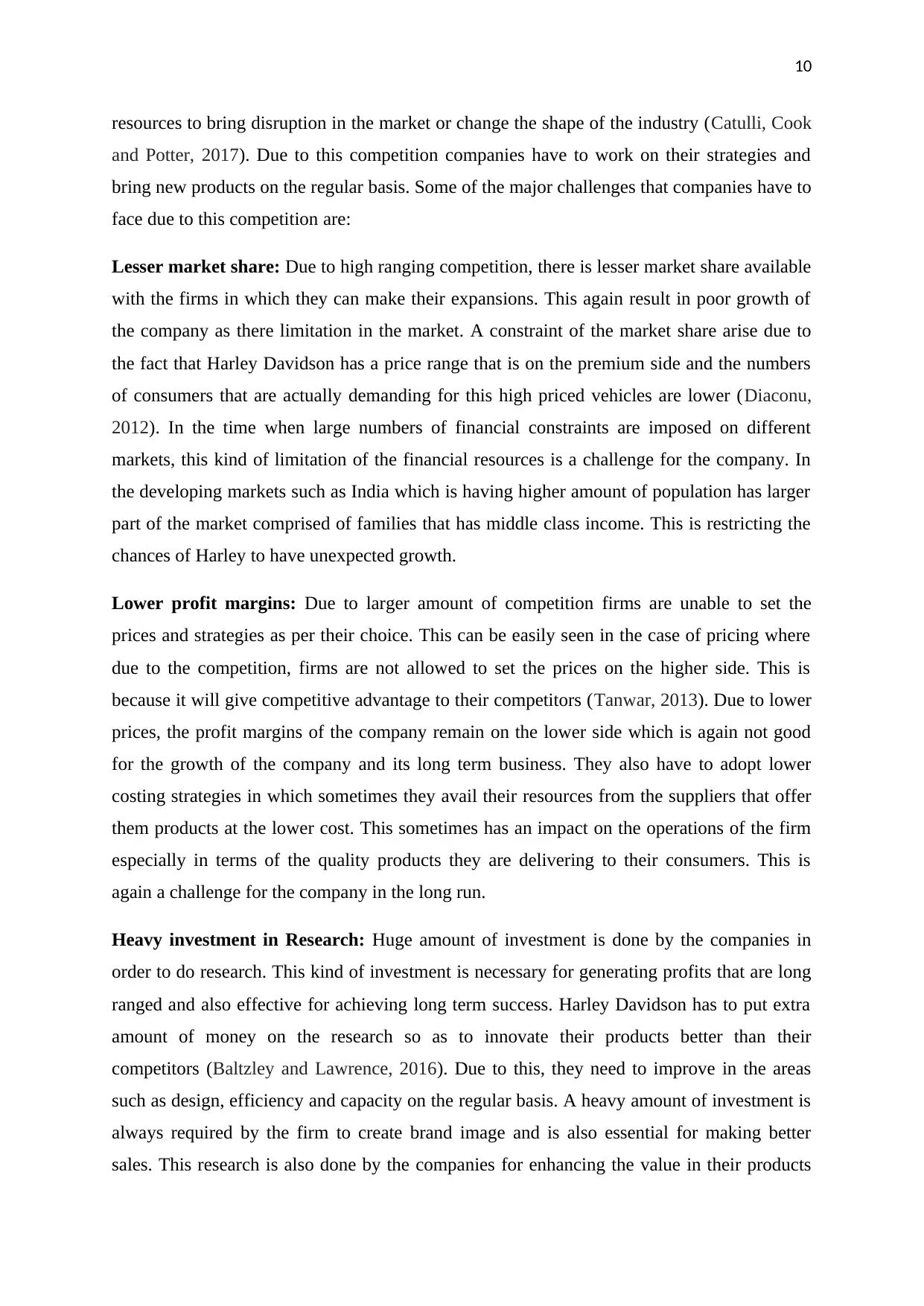
10
resources to bring disruption in the market or change the shape of the industry (Catulli, Cook
and Potter, 2017). Due to this competition companies have to work on their strategies and
bring new products on the regular basis. Some of the major challenges that companies have to
face due to this competition are:
Lesser market share: Due to high ranging competition, there is lesser market share available
with the firms in which they can make their expansions. This again result in poor growth of
the company as there limitation in the market. A constraint of the market share arise due to
the fact that Harley Davidson has a price range that is on the premium side and the numbers
of consumers that are actually demanding for this high priced vehicles are lower (Diaconu,
2012). In the time when large numbers of financial constraints are imposed on different
markets, this kind of limitation of the financial resources is a challenge for the company. In
the developing markets such as India which is having higher amount of population has larger
part of the market comprised of families that has middle class income. This is restricting the
chances of Harley to have unexpected growth.
Lower profit margins: Due to larger amount of competition firms are unable to set the
prices and strategies as per their choice. This can be easily seen in the case of pricing where
due to the competition, firms are not allowed to set the prices on the higher side. This is
because it will give competitive advantage to their competitors (Tanwar, 2013). Due to lower
prices, the profit margins of the company remain on the lower side which is again not good
for the growth of the company and its long term business. They also have to adopt lower
costing strategies in which sometimes they avail their resources from the suppliers that offer
them products at the lower cost. This sometimes has an impact on the operations of the firm
especially in terms of the quality products they are delivering to their consumers. This is
again a challenge for the company in the long run.
Heavy investment in Research: Huge amount of investment is done by the companies in
order to do research. This kind of investment is necessary for generating profits that are long
ranged and also effective for achieving long term success. Harley Davidson has to put extra
amount of money on the research so as to innovate their products better than their
competitors (Baltzley and Lawrence, 2016). Due to this, they need to improve in the areas
such as design, efficiency and capacity on the regular basis. A heavy amount of investment is
always required by the firm to create brand image and is also essential for making better
sales. This research is also done by the companies for enhancing the value in their products
resources to bring disruption in the market or change the shape of the industry (Catulli, Cook
and Potter, 2017). Due to this competition companies have to work on their strategies and
bring new products on the regular basis. Some of the major challenges that companies have to
face due to this competition are:
Lesser market share: Due to high ranging competition, there is lesser market share available
with the firms in which they can make their expansions. This again result in poor growth of
the company as there limitation in the market. A constraint of the market share arise due to
the fact that Harley Davidson has a price range that is on the premium side and the numbers
of consumers that are actually demanding for this high priced vehicles are lower (Diaconu,
2012). In the time when large numbers of financial constraints are imposed on different
markets, this kind of limitation of the financial resources is a challenge for the company. In
the developing markets such as India which is having higher amount of population has larger
part of the market comprised of families that has middle class income. This is restricting the
chances of Harley to have unexpected growth.
Lower profit margins: Due to larger amount of competition firms are unable to set the
prices and strategies as per their choice. This can be easily seen in the case of pricing where
due to the competition, firms are not allowed to set the prices on the higher side. This is
because it will give competitive advantage to their competitors (Tanwar, 2013). Due to lower
prices, the profit margins of the company remain on the lower side which is again not good
for the growth of the company and its long term business. They also have to adopt lower
costing strategies in which sometimes they avail their resources from the suppliers that offer
them products at the lower cost. This sometimes has an impact on the operations of the firm
especially in terms of the quality products they are delivering to their consumers. This is
again a challenge for the company in the long run.
Heavy investment in Research: Huge amount of investment is done by the companies in
order to do research. This kind of investment is necessary for generating profits that are long
ranged and also effective for achieving long term success. Harley Davidson has to put extra
amount of money on the research so as to innovate their products better than their
competitors (Baltzley and Lawrence, 2016). Due to this, they need to improve in the areas
such as design, efficiency and capacity on the regular basis. A heavy amount of investment is
always required by the firm to create brand image and is also essential for making better
sales. This research is also done by the companies for enhancing the value in their products
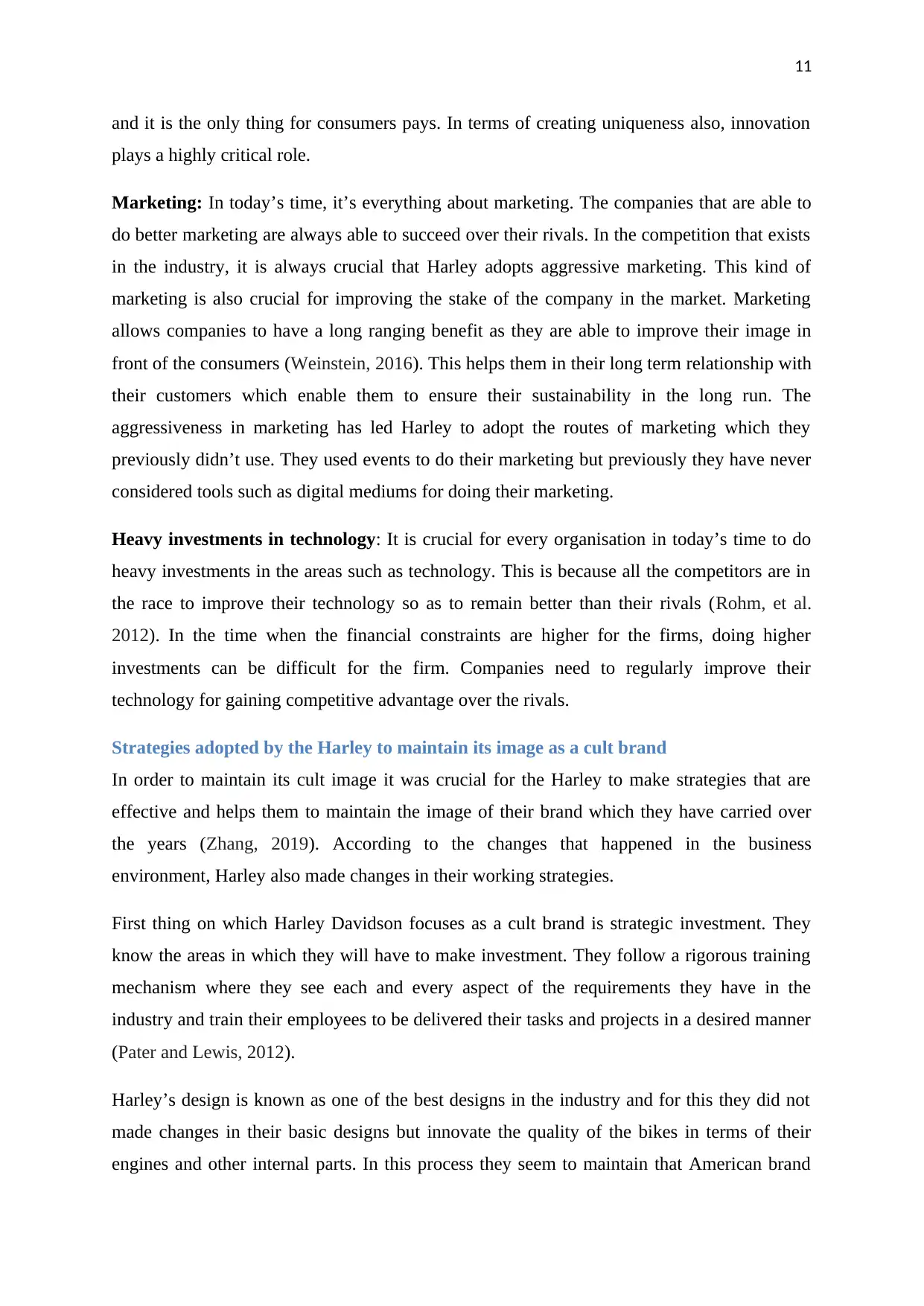
11
and it is the only thing for consumers pays. In terms of creating uniqueness also, innovation
plays a highly critical role.
Marketing: In today’s time, it’s everything about marketing. The companies that are able to
do better marketing are always able to succeed over their rivals. In the competition that exists
in the industry, it is always crucial that Harley adopts aggressive marketing. This kind of
marketing is also crucial for improving the stake of the company in the market. Marketing
allows companies to have a long ranging benefit as they are able to improve their image in
front of the consumers (Weinstein, 2016). This helps them in their long term relationship with
their customers which enable them to ensure their sustainability in the long run. The
aggressiveness in marketing has led Harley to adopt the routes of marketing which they
previously didn’t use. They used events to do their marketing but previously they have never
considered tools such as digital mediums for doing their marketing.
Heavy investments in technology: It is crucial for every organisation in today’s time to do
heavy investments in the areas such as technology. This is because all the competitors are in
the race to improve their technology so as to remain better than their rivals (Rohm, et al.
2012). In the time when the financial constraints are higher for the firms, doing higher
investments can be difficult for the firm. Companies need to regularly improve their
technology for gaining competitive advantage over the rivals.
Strategies adopted by the Harley to maintain its image as a cult brand
In order to maintain its cult image it was crucial for the Harley to make strategies that are
effective and helps them to maintain the image of their brand which they have carried over
the years (Zhang, 2019). According to the changes that happened in the business
environment, Harley also made changes in their working strategies.
First thing on which Harley Davidson focuses as a cult brand is strategic investment. They
know the areas in which they will have to make investment. They follow a rigorous training
mechanism where they see each and every aspect of the requirements they have in the
industry and train their employees to be delivered their tasks and projects in a desired manner
(Pater and Lewis, 2012).
Harley’s design is known as one of the best designs in the industry and for this they did not
made changes in their basic designs but innovate the quality of the bikes in terms of their
engines and other internal parts. In this process they seem to maintain that American brand
and it is the only thing for consumers pays. In terms of creating uniqueness also, innovation
plays a highly critical role.
Marketing: In today’s time, it’s everything about marketing. The companies that are able to
do better marketing are always able to succeed over their rivals. In the competition that exists
in the industry, it is always crucial that Harley adopts aggressive marketing. This kind of
marketing is also crucial for improving the stake of the company in the market. Marketing
allows companies to have a long ranging benefit as they are able to improve their image in
front of the consumers (Weinstein, 2016). This helps them in their long term relationship with
their customers which enable them to ensure their sustainability in the long run. The
aggressiveness in marketing has led Harley to adopt the routes of marketing which they
previously didn’t use. They used events to do their marketing but previously they have never
considered tools such as digital mediums for doing their marketing.
Heavy investments in technology: It is crucial for every organisation in today’s time to do
heavy investments in the areas such as technology. This is because all the competitors are in
the race to improve their technology so as to remain better than their rivals (Rohm, et al.
2012). In the time when the financial constraints are higher for the firms, doing higher
investments can be difficult for the firm. Companies need to regularly improve their
technology for gaining competitive advantage over the rivals.
Strategies adopted by the Harley to maintain its image as a cult brand
In order to maintain its cult image it was crucial for the Harley to make strategies that are
effective and helps them to maintain the image of their brand which they have carried over
the years (Zhang, 2019). According to the changes that happened in the business
environment, Harley also made changes in their working strategies.
First thing on which Harley Davidson focuses as a cult brand is strategic investment. They
know the areas in which they will have to make investment. They follow a rigorous training
mechanism where they see each and every aspect of the requirements they have in the
industry and train their employees to be delivered their tasks and projects in a desired manner
(Pater and Lewis, 2012).
Harley’s design is known as one of the best designs in the industry and for this they did not
made changes in their basic designs but innovate the quality of the bikes in terms of their
engines and other internal parts. In this process they seem to maintain that American brand
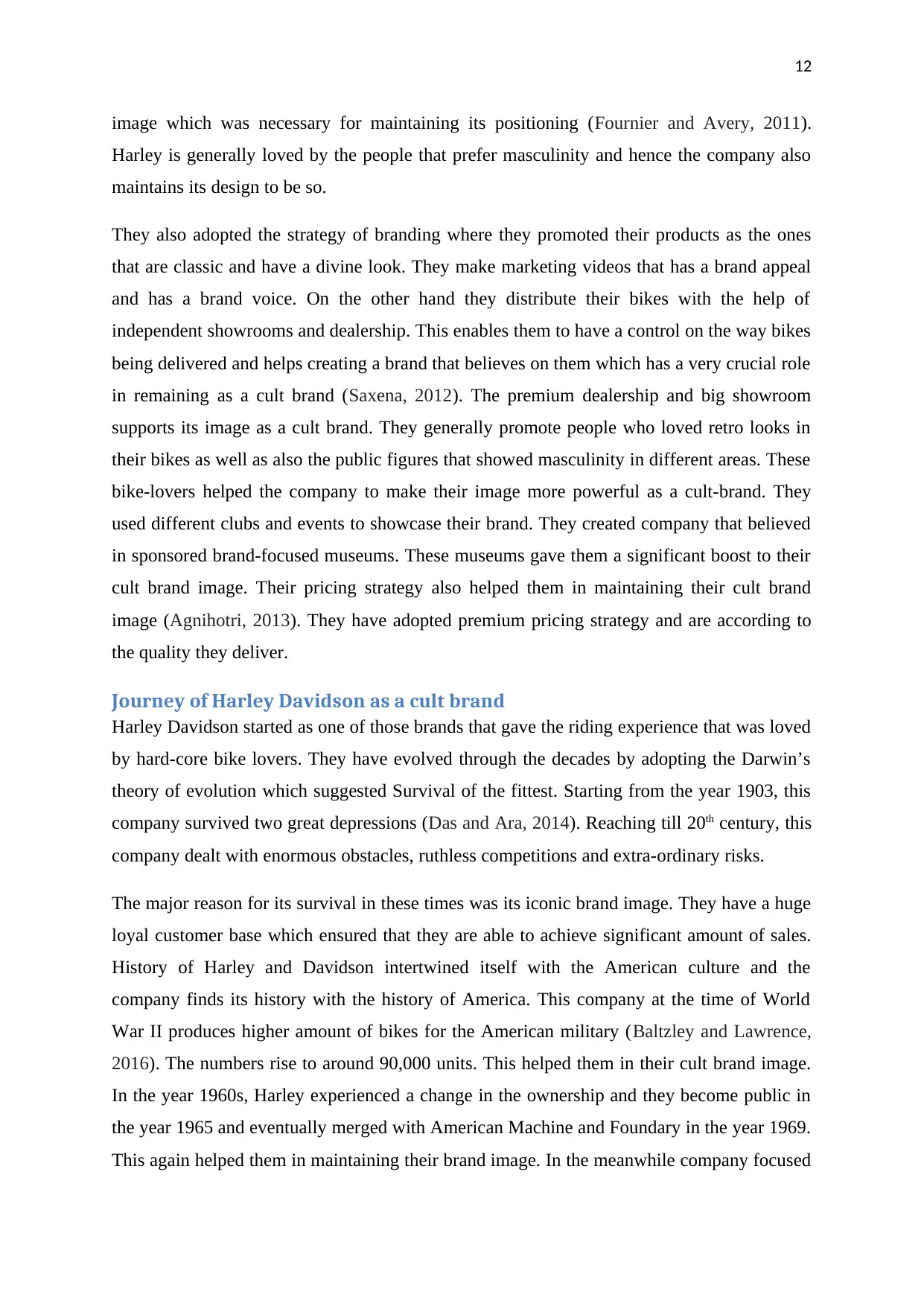
12
image which was necessary for maintaining its positioning (Fournier and Avery, 2011).
Harley is generally loved by the people that prefer masculinity and hence the company also
maintains its design to be so.
They also adopted the strategy of branding where they promoted their products as the ones
that are classic and have a divine look. They make marketing videos that has a brand appeal
and has a brand voice. On the other hand they distribute their bikes with the help of
independent showrooms and dealership. This enables them to have a control on the way bikes
being delivered and helps creating a brand that believes on them which has a very crucial role
in remaining as a cult brand (Saxena, 2012). The premium dealership and big showroom
supports its image as a cult brand. They generally promote people who loved retro looks in
their bikes as well as also the public figures that showed masculinity in different areas. These
bike-lovers helped the company to make their image more powerful as a cult-brand. They
used different clubs and events to showcase their brand. They created company that believed
in sponsored brand-focused museums. These museums gave them a significant boost to their
cult brand image. Their pricing strategy also helped them in maintaining their cult brand
image (Agnihotri, 2013). They have adopted premium pricing strategy and are according to
the quality they deliver.
Journey of Harley Davidson as a cult brand
Harley Davidson started as one of those brands that gave the riding experience that was loved
by hard-core bike lovers. They have evolved through the decades by adopting the Darwin’s
theory of evolution which suggested Survival of the fittest. Starting from the year 1903, this
company survived two great depressions (Das and Ara, 2014). Reaching till 20th century, this
company dealt with enormous obstacles, ruthless competitions and extra-ordinary risks.
The major reason for its survival in these times was its iconic brand image. They have a huge
loyal customer base which ensured that they are able to achieve significant amount of sales.
History of Harley and Davidson intertwined itself with the American culture and the
company finds its history with the history of America. This company at the time of World
War II produces higher amount of bikes for the American military (Baltzley and Lawrence,
2016). The numbers rise to around 90,000 units. This helped them in their cult brand image.
In the year 1960s, Harley experienced a change in the ownership and they become public in
the year 1965 and eventually merged with American Machine and Foundary in the year 1969.
This again helped them in maintaining their brand image. In the meanwhile company focused
image which was necessary for maintaining its positioning (Fournier and Avery, 2011).
Harley is generally loved by the people that prefer masculinity and hence the company also
maintains its design to be so.
They also adopted the strategy of branding where they promoted their products as the ones
that are classic and have a divine look. They make marketing videos that has a brand appeal
and has a brand voice. On the other hand they distribute their bikes with the help of
independent showrooms and dealership. This enables them to have a control on the way bikes
being delivered and helps creating a brand that believes on them which has a very crucial role
in remaining as a cult brand (Saxena, 2012). The premium dealership and big showroom
supports its image as a cult brand. They generally promote people who loved retro looks in
their bikes as well as also the public figures that showed masculinity in different areas. These
bike-lovers helped the company to make their image more powerful as a cult-brand. They
used different clubs and events to showcase their brand. They created company that believed
in sponsored brand-focused museums. These museums gave them a significant boost to their
cult brand image. Their pricing strategy also helped them in maintaining their cult brand
image (Agnihotri, 2013). They have adopted premium pricing strategy and are according to
the quality they deliver.
Journey of Harley Davidson as a cult brand
Harley Davidson started as one of those brands that gave the riding experience that was loved
by hard-core bike lovers. They have evolved through the decades by adopting the Darwin’s
theory of evolution which suggested Survival of the fittest. Starting from the year 1903, this
company survived two great depressions (Das and Ara, 2014). Reaching till 20th century, this
company dealt with enormous obstacles, ruthless competitions and extra-ordinary risks.
The major reason for its survival in these times was its iconic brand image. They have a huge
loyal customer base which ensured that they are able to achieve significant amount of sales.
History of Harley and Davidson intertwined itself with the American culture and the
company finds its history with the history of America. This company at the time of World
War II produces higher amount of bikes for the American military (Baltzley and Lawrence,
2016). The numbers rise to around 90,000 units. This helped them in their cult brand image.
In the year 1960s, Harley experienced a change in the ownership and they become public in
the year 1965 and eventually merged with American Machine and Foundary in the year 1969.
This again helped them in maintaining their brand image. In the meanwhile company focused
Paraphrase This Document
Need a fresh take? Get an instant paraphrase of this document with our AI Paraphraser
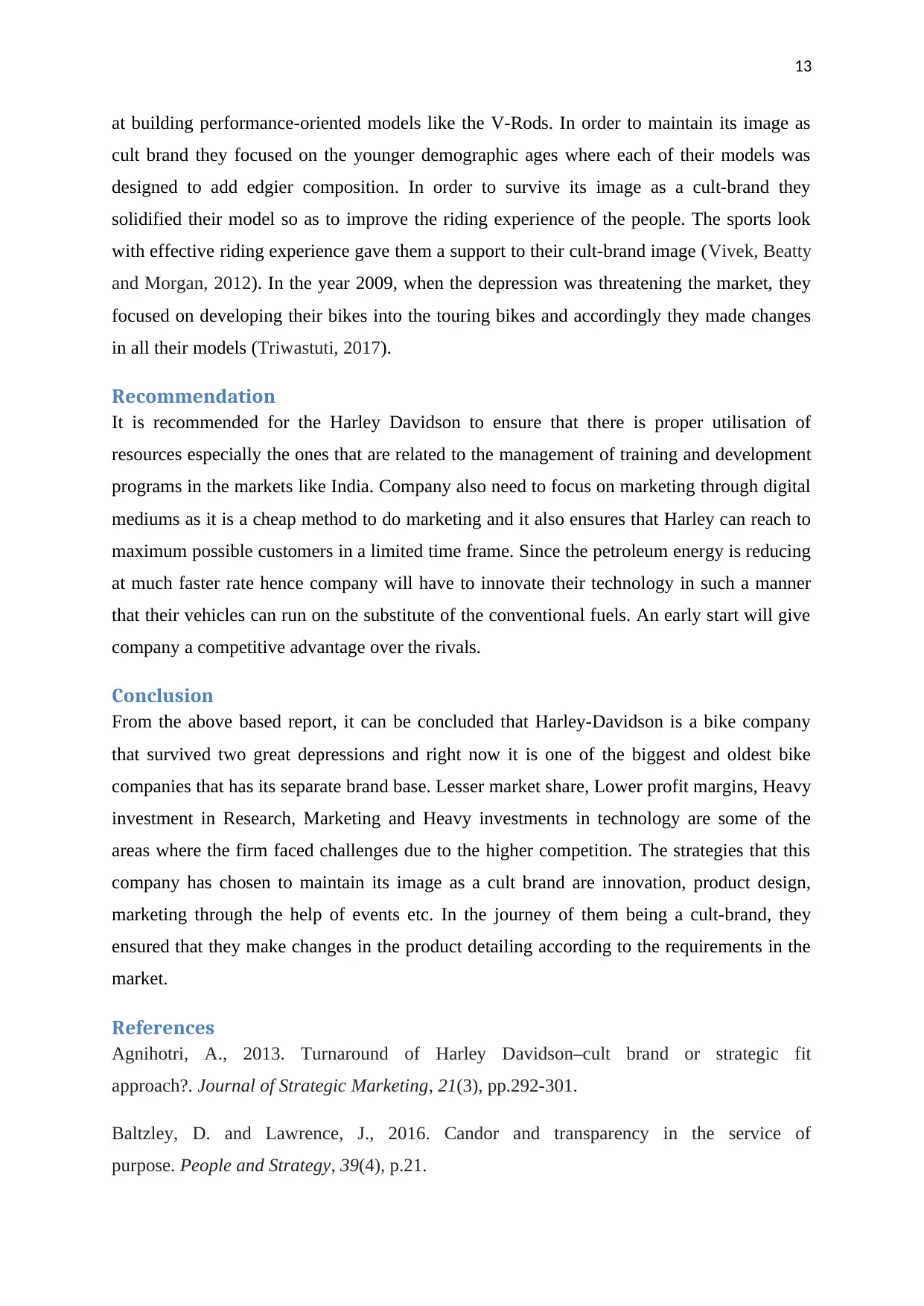
13
at building performance-oriented models like the V-Rods. In order to maintain its image as
cult brand they focused on the younger demographic ages where each of their models was
designed to add edgier composition. In order to survive its image as a cult-brand they
solidified their model so as to improve the riding experience of the people. The sports look
with effective riding experience gave them a support to their cult-brand image (Vivek, Beatty
and Morgan, 2012). In the year 2009, when the depression was threatening the market, they
focused on developing their bikes into the touring bikes and accordingly they made changes
in all their models (Triwastuti, 2017).
Recommendation
It is recommended for the Harley Davidson to ensure that there is proper utilisation of
resources especially the ones that are related to the management of training and development
programs in the markets like India. Company also need to focus on marketing through digital
mediums as it is a cheap method to do marketing and it also ensures that Harley can reach to
maximum possible customers in a limited time frame. Since the petroleum energy is reducing
at much faster rate hence company will have to innovate their technology in such a manner
that their vehicles can run on the substitute of the conventional fuels. An early start will give
company a competitive advantage over the rivals.
Conclusion
From the above based report, it can be concluded that Harley-Davidson is a bike company
that survived two great depressions and right now it is one of the biggest and oldest bike
companies that has its separate brand base. Lesser market share, Lower profit margins, Heavy
investment in Research, Marketing and Heavy investments in technology are some of the
areas where the firm faced challenges due to the higher competition. The strategies that this
company has chosen to maintain its image as a cult brand are innovation, product design,
marketing through the help of events etc. In the journey of them being a cult-brand, they
ensured that they make changes in the product detailing according to the requirements in the
market.
References
Agnihotri, A., 2013. Turnaround of Harley Davidson–cult brand or strategic fit
approach?. Journal of Strategic Marketing, 21(3), pp.292-301.
Baltzley, D. and Lawrence, J., 2016. Candor and transparency in the service of
purpose. People and Strategy, 39(4), p.21.
at building performance-oriented models like the V-Rods. In order to maintain its image as
cult brand they focused on the younger demographic ages where each of their models was
designed to add edgier composition. In order to survive its image as a cult-brand they
solidified their model so as to improve the riding experience of the people. The sports look
with effective riding experience gave them a support to their cult-brand image (Vivek, Beatty
and Morgan, 2012). In the year 2009, when the depression was threatening the market, they
focused on developing their bikes into the touring bikes and accordingly they made changes
in all their models (Triwastuti, 2017).
Recommendation
It is recommended for the Harley Davidson to ensure that there is proper utilisation of
resources especially the ones that are related to the management of training and development
programs in the markets like India. Company also need to focus on marketing through digital
mediums as it is a cheap method to do marketing and it also ensures that Harley can reach to
maximum possible customers in a limited time frame. Since the petroleum energy is reducing
at much faster rate hence company will have to innovate their technology in such a manner
that their vehicles can run on the substitute of the conventional fuels. An early start will give
company a competitive advantage over the rivals.
Conclusion
From the above based report, it can be concluded that Harley-Davidson is a bike company
that survived two great depressions and right now it is one of the biggest and oldest bike
companies that has its separate brand base. Lesser market share, Lower profit margins, Heavy
investment in Research, Marketing and Heavy investments in technology are some of the
areas where the firm faced challenges due to the higher competition. The strategies that this
company has chosen to maintain its image as a cult brand are innovation, product design,
marketing through the help of events etc. In the journey of them being a cult-brand, they
ensured that they make changes in the product detailing according to the requirements in the
market.
References
Agnihotri, A., 2013. Turnaround of Harley Davidson–cult brand or strategic fit
approach?. Journal of Strategic Marketing, 21(3), pp.292-301.
Baltzley, D. and Lawrence, J., 2016. Candor and transparency in the service of
purpose. People and Strategy, 39(4), p.21.
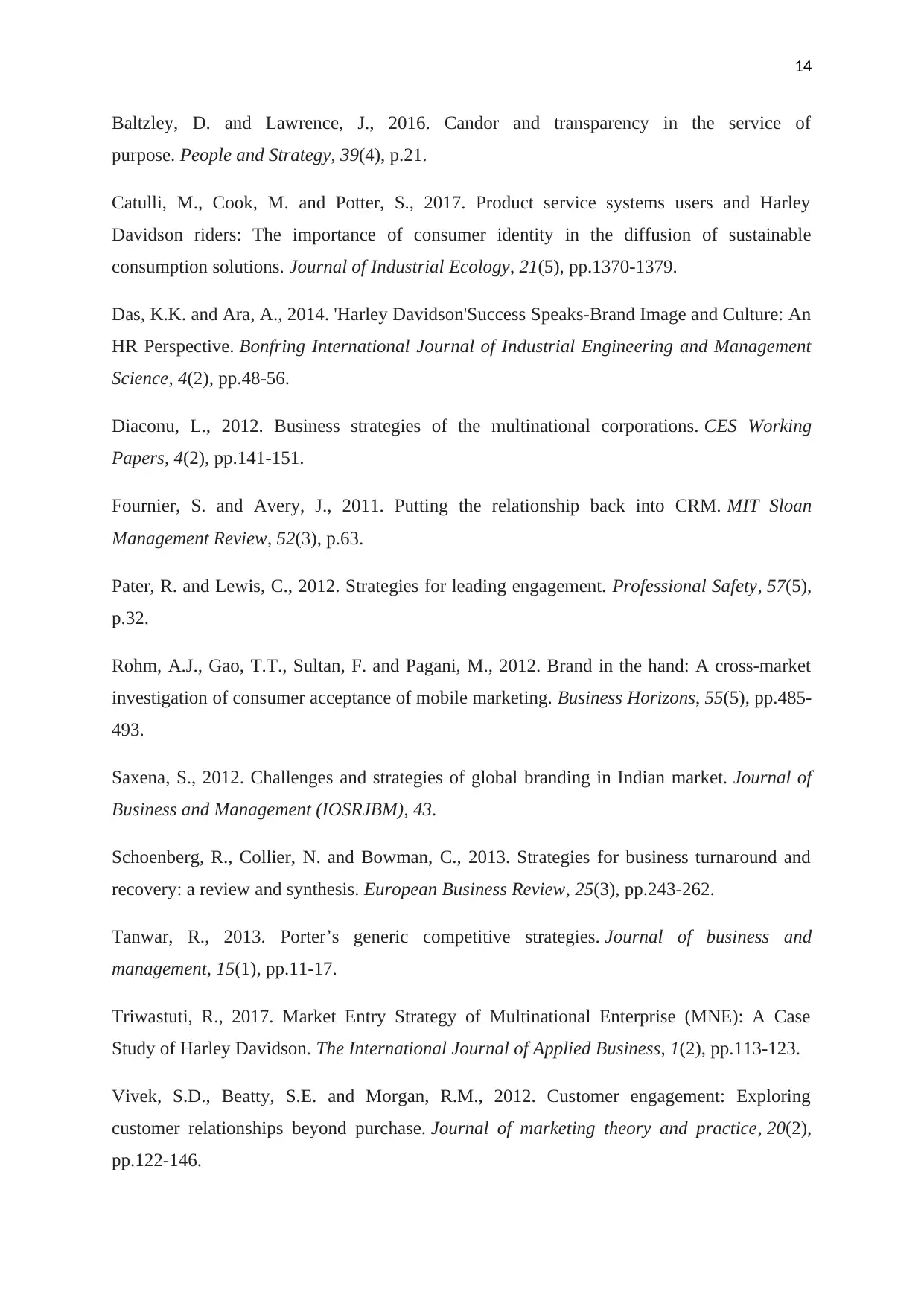
14
Baltzley, D. and Lawrence, J., 2016. Candor and transparency in the service of
purpose. People and Strategy, 39(4), p.21.
Catulli, M., Cook, M. and Potter, S., 2017. Product service systems users and Harley
Davidson riders: The importance of consumer identity in the diffusion of sustainable
consumption solutions. Journal of Industrial Ecology, 21(5), pp.1370-1379.
Das, K.K. and Ara, A., 2014. 'Harley Davidson'Success Speaks-Brand Image and Culture: An
HR Perspective. Bonfring International Journal of Industrial Engineering and Management
Science, 4(2), pp.48-56.
Diaconu, L., 2012. Business strategies of the multinational corporations. CES Working
Papers, 4(2), pp.141-151.
Fournier, S. and Avery, J., 2011. Putting the relationship back into CRM. MIT Sloan
Management Review, 52(3), p.63.
Pater, R. and Lewis, C., 2012. Strategies for leading engagement. Professional Safety, 57(5),
p.32.
Rohm, A.J., Gao, T.T., Sultan, F. and Pagani, M., 2012. Brand in the hand: A cross-market
investigation of consumer acceptance of mobile marketing. Business Horizons, 55(5), pp.485-
493.
Saxena, S., 2012. Challenges and strategies of global branding in Indian market. Journal of
Business and Management (IOSRJBM), 43.
Schoenberg, R., Collier, N. and Bowman, C., 2013. Strategies for business turnaround and
recovery: a review and synthesis. European Business Review, 25(3), pp.243-262.
Tanwar, R., 2013. Porter’s generic competitive strategies. Journal of business and
management, 15(1), pp.11-17.
Triwastuti, R., 2017. Market Entry Strategy of Multinational Enterprise (MNE): A Case
Study of Harley Davidson. The International Journal of Applied Business, 1(2), pp.113-123.
Vivek, S.D., Beatty, S.E. and Morgan, R.M., 2012. Customer engagement: Exploring
customer relationships beyond purchase. Journal of marketing theory and practice, 20(2),
pp.122-146.
Baltzley, D. and Lawrence, J., 2016. Candor and transparency in the service of
purpose. People and Strategy, 39(4), p.21.
Catulli, M., Cook, M. and Potter, S., 2017. Product service systems users and Harley
Davidson riders: The importance of consumer identity in the diffusion of sustainable
consumption solutions. Journal of Industrial Ecology, 21(5), pp.1370-1379.
Das, K.K. and Ara, A., 2014. 'Harley Davidson'Success Speaks-Brand Image and Culture: An
HR Perspective. Bonfring International Journal of Industrial Engineering and Management
Science, 4(2), pp.48-56.
Diaconu, L., 2012. Business strategies of the multinational corporations. CES Working
Papers, 4(2), pp.141-151.
Fournier, S. and Avery, J., 2011. Putting the relationship back into CRM. MIT Sloan
Management Review, 52(3), p.63.
Pater, R. and Lewis, C., 2012. Strategies for leading engagement. Professional Safety, 57(5),
p.32.
Rohm, A.J., Gao, T.T., Sultan, F. and Pagani, M., 2012. Brand in the hand: A cross-market
investigation of consumer acceptance of mobile marketing. Business Horizons, 55(5), pp.485-
493.
Saxena, S., 2012. Challenges and strategies of global branding in Indian market. Journal of
Business and Management (IOSRJBM), 43.
Schoenberg, R., Collier, N. and Bowman, C., 2013. Strategies for business turnaround and
recovery: a review and synthesis. European Business Review, 25(3), pp.243-262.
Tanwar, R., 2013. Porter’s generic competitive strategies. Journal of business and
management, 15(1), pp.11-17.
Triwastuti, R., 2017. Market Entry Strategy of Multinational Enterprise (MNE): A Case
Study of Harley Davidson. The International Journal of Applied Business, 1(2), pp.113-123.
Vivek, S.D., Beatty, S.E. and Morgan, R.M., 2012. Customer engagement: Exploring
customer relationships beyond purchase. Journal of marketing theory and practice, 20(2),
pp.122-146.
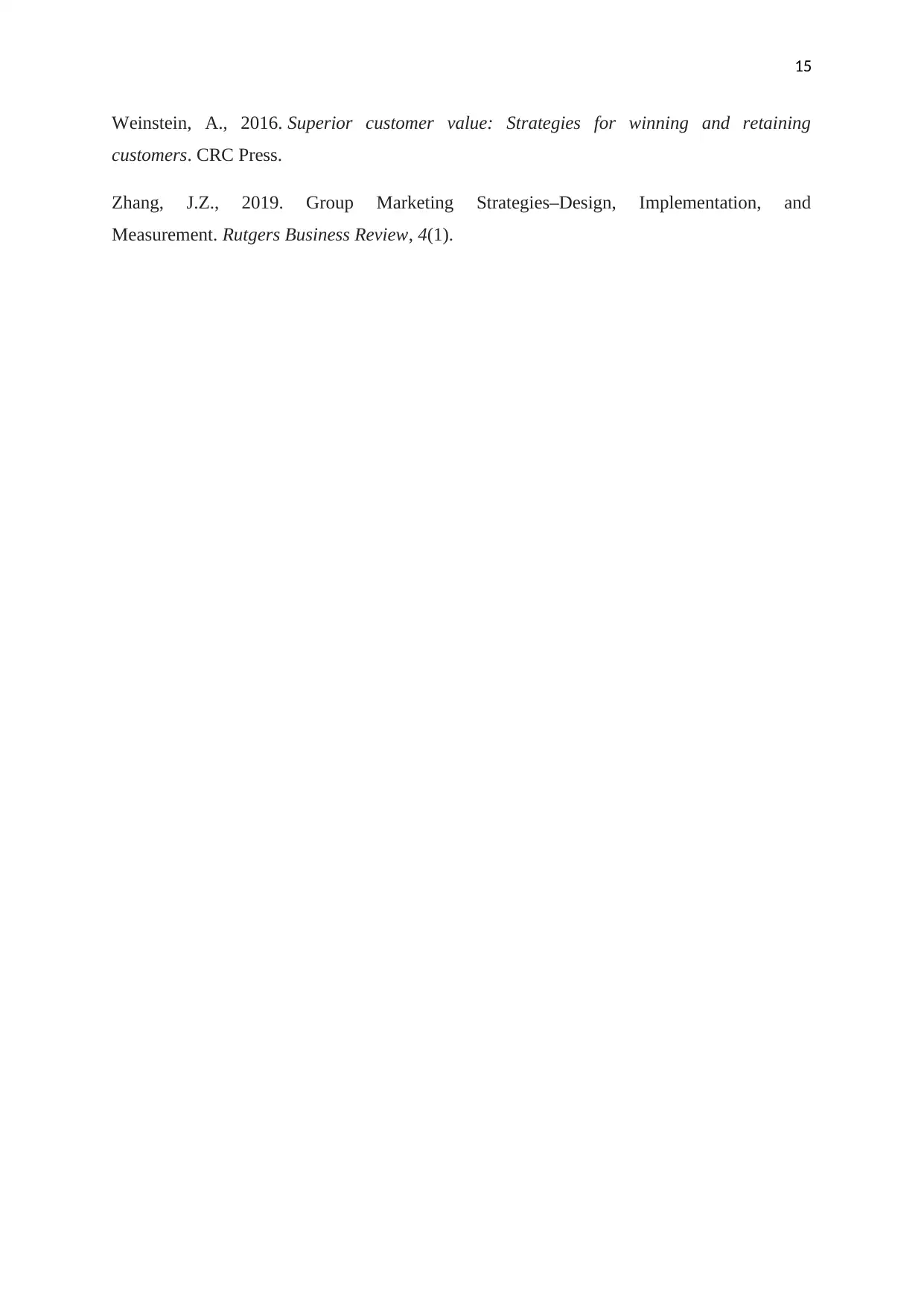
15
Weinstein, A., 2016. Superior customer value: Strategies for winning and retaining
customers. CRC Press.
Zhang, J.Z., 2019. Group Marketing Strategies–Design, Implementation, and
Measurement. Rutgers Business Review, 4(1).
Weinstein, A., 2016. Superior customer value: Strategies for winning and retaining
customers. CRC Press.
Zhang, J.Z., 2019. Group Marketing Strategies–Design, Implementation, and
Measurement. Rutgers Business Review, 4(1).
1 out of 16
Related Documents
Your All-in-One AI-Powered Toolkit for Academic Success.
+13062052269
info@desklib.com
Available 24*7 on WhatsApp / Email
![[object Object]](/_next/static/media/star-bottom.7253800d.svg)
Unlock your academic potential
© 2024 | Zucol Services PVT LTD | All rights reserved.





